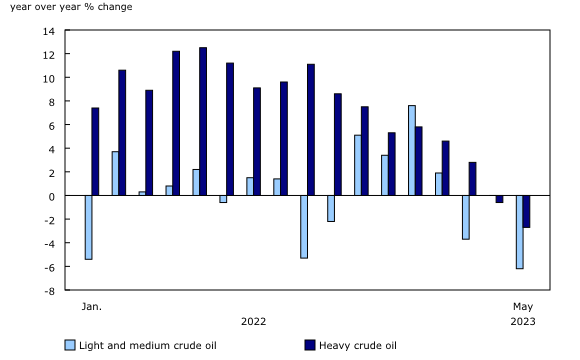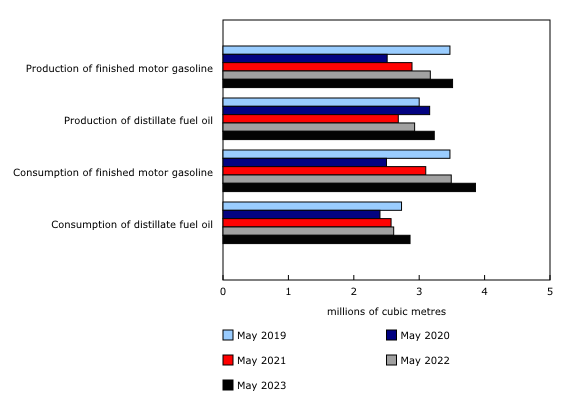Energy statistics, May 2023
Released: 2023-08-04
Primary energy production decreased 0.6% year over year to 1.9 million terajoules in May, on the heels of a 0.7% increase in April. This was the first year-over-year decline in production since January 2022. Reasons for the decline in May 2023 include several natural gas facilities in Alberta, which were impacted by forest fires as well as lower crude oil production (-2.6%) due to annual maintenance at a number of oilsands upgrading facilities and bitumen mines.
Secondary energy production increased 8.7% in May, due to higher output of refined petroleum products.
For more information on energy in Canada, including production, consumption, international trade and much more, please visit the Canadian Centre for Energy Information portal and follow #energynews on social media.
Crude production down amid maintenance and forest fires
The production of crude oil and equivalent products fell 2.6% to 22.1 million cubic metres in May. This was the second consecutive monthly year-over-year decline, as scheduled spring turnarounds continued and the danger from forest fires in western Canada had a negative effect on overall production.
Oil extraction drove the overall decrease, down 5.0% to 5.9 million cubic metres in May, as forest fires caused some producers to temporarily slow or stop production. Production of light and medium crude oil was most impacted, down 6.2% year over year, while heavy crude oil production fell 2.7%.
Oilsands extraction was 14.2 million cubic metres in May, down 0.5% from the same month a year earlier. Annual spring turnarounds at multiple upgraders and bitumen mines were the main cause of the decline in May 2023. Production of crude bitumen decreased 2.9%, partially offset by a 3.8% rise in the production of synthetic crude.
According to the Raw Material Price Index, crude oil and bitumen prices were down 32.2% year over year, continuing the downward trend.
Production and consumption of gasoline and distillates set series highs for May
Production of finished petroleum products rose 9.2% year over year in May, due to increases from finished motor gasoline (+10.8%) and distillate fuel oil (+10.3%). Both gasoline (3.5 million cubic metres) and distillates (3.2 million cubic metres) recorded the highest May production level since this series began in 2019. Meanwhile, production of renewable fuels rose 0.8% in May compared with May 2022.
Consumption of finished petroleum products climbed 13.0% year over year in May 2023. Like production, consumption of finished motor gasoline (+10.7%) and distillate fuel oil (+9.6%) also recorded the highest May levels for this series.
Forest fires prompt declines in natural gas production and exports, while injections to storage increase
Production of marketable natural gas declined 4.0% year over year to 610.3 million gigajoules in May, the first decline since March 2021, as the forest fires in Alberta caused some producers to temporarily stop production.
Closing inventories of natural gas held in Canadian facilities stood at 824.8 million gigajoules in May 2023, the highest May level since 2016. Natural gas injections to inventories have been strong in recent months, fuelled by lower exports and impacts of forest fires.
Meanwhile, exports of Canadian natural gas to the United States fell 7.3% year over year to 241.6 million gigajoules in May. The decline was the result of lower demand for Canadian natural gas, as inventories in the US remained high. In addition, there were reduced export pipeline volumes due to the impact of the forest fires.
For more information on the natural gas sector, please see this recent Statistics Canada article: Natural gas: Record amount stored and consumed in 2022, but inventory declining
Electricity generation and consumption edge up in May
Total electricity generation rose 0.3% to 48.0 million megawatt-hours (MWh) in May compared with a year earlier, following a 2.2% decline in April.
Nuclear generation was largely responsible for the overall increase in May, up 10.8% to 6.5 million MWh. In May 2022, nuclear generation was low due to maintenance at Ontario's Bruce Power and New Brunswick's Point Lepreau Nuclear Generating Stations.
Hydroelectricity generation was down 3.0% in May due to declines in Quebec (-4.7%) and British Columbia (-11.0%). British Columbia continued to experience dryer-than-normal conditions, which reduced reservoir levels and hydroelectric generation. Meanwhile, Quebec's generation may have been reduced due to cooler temperatures and resulting lower export demand in the northeastern United States compared with May 2022, according to the United States National Centers for Environmental Information.
Furthermore, consumption of electricity rose 0.5% to 44.1 million MWh in May 2023, while imports (-15.0%) and exports (-4.8%) declined.
Note to readers
The consolidated energy statistics table (25-10-0079-01) presents monthly data on primary and secondary energy by fuel type (crude oil, natural gas, electricity, coal, etc.) in terajoules and supply and demand characteristics (production, exports, imports, etc.) for Canada. The table uses data from a variety of survey and administrative sources. Estimates are available starting with the January 2020 reference month. For more information, please consult the Consolidated Energy Statistics Table: User Guide.
The survey programs which support the "Energy statistics" release include:
- Crude oil and natural gas (survey number 2198; tables 25-10-0036-01, 25-10-0055-01 and 25-10-0063-01). Data for April 2023 have been revised.
- Energy transportation and storage (survey number 5300, tables 25-10-0075-01 and 25-10-0077-01).
- Natural gas transmission, storage and distribution (survey numbers 2149, 5210 and 5215; tables 25-10-0057-01, 25-10-0058-01 and 25-10-0059-01).
- Refined petroleum products (survey number 2150, table 25-10-0081-01).
- Renewable fuel plant statistics (survey number 5294, table 25-10-0082-01).
- Electric power statistics (survey number 2151, tables 25-10-0015-01 and 25-10-0016-01).
- Coal and coke statistics (survey numbers 2147 and 2003, tables 25-10-0045-01 and 25-10-0046-01). Data for January to April 2023 have been revised.
Data are subject to revisions. Energy data and other supporting data used in the text are revised on an ongoing basis for each month of the current year to reflect new information provided by respondents and updates to administrative data. Historical revisions are also performed periodically.
Definitions, data sources and methods for each survey program are available under the respective survey number.
The Energy Statistics Program relies on data collected from respondents and administrative sources.
Data in this release are not seasonally adjusted.
Occasionally, data from Environment and Climate Change Canada is referenced by the Energy Statistics Program using Heating Degree Days (HDDs) as a measure of temperature. HDDs reflect the relationship between outdoor temperatures and the need to heat indoors to maintain room temperature. As temperatures outside fall, the number of HDDs increases.
Contact information
For more information, or to enquire about the concepts, methods or data quality of this release, contact us (toll-free 1-800-263-1136; 514-283-8300; infostats@statcan.gc.ca) or Media Relations (statcan.mediahotline-ligneinfomedias.statcan@statcan.gc.ca).
- Date modified:







